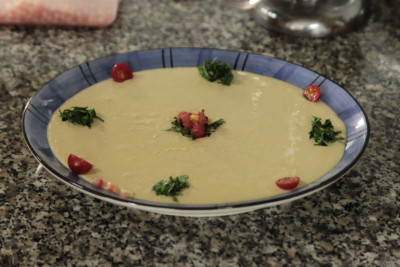Hoummos
 Along with tabbouleh, hoummos is undoubtedly the best-known preparation in Lebanese cuisine. In Lebanon, hummus is a very popular dish, also known as “hommos” or “houmous”. Indeed, hummus means “chickpea purée”, but it’s also the chickpea itself that the word indicates. Hummus name varies according to the topping added to the basic mixture.
Along with tabbouleh, hoummos is undoubtedly the best-known preparation in Lebanese cuisine. In Lebanon, hummus is a very popular dish, also known as “hommos” or “houmous”. Indeed, hummus means “chickpea purée”, but it’s also the chickpea itself that the word indicates. Hummus name varies according to the topping added to the basic mixture.
Bel tahini hummus is the common variant of traditional hummus in which more tahini (sesame paste) is used, giving it a stronger flavor and creamier texture. It’s a very fine purée made from cooked chickpeas and tahini (sesame paste), accompanied by garlic, lemon juice and salt mixed until smooth and creamy. Olive oil, chopped parsley or tomatoes and, paprika are just some of the toppings that can be added to hummus.
Bel awarma hummus is a mutation of traditional Lebanese hummus, where awarma meat is added for extra flavor and texture. Awarma is a candied, salted meat, usually made from lamb or beef. It is slowly cooked in its own fat with spices and aromatics to obtain a tender, flavorful meat. Awarma was prepared by mountain dwellers before the advent of refrigerators, as a precaution against the long winter days. Adding awarma to hummus adds a richer flavor.
Hummus with beef meat cut into small peaces and pine nuts.This variation adds a touch of strength and indulgence to the classic hummus, combining the purity of the chickpeas with the richness of the meat and the crunch of the pine nuts.
Hummus is considered an essential part of Lebanese cuisine and is often served as an entrée and a mezze (a selection of small dishes shared between guests). Hummus is usually served with warm pita bread and can be accompanied by other mezze such as moutabbal (grilled eggplant purée), labneh (cottage cheese) or tabouleh (parsley and bulgur salad).
Hummus is appreciated for its soft texture, slightly lemony taste and delicate flavor. It’s a versatile dish that can be enjoyed as a dip, used as a sandwich filling or accompanied by fresh vegetables.
A popular Lebanese dish, hummus is enjoyed in many countries around the world and has become an internationally recognized specialty.

